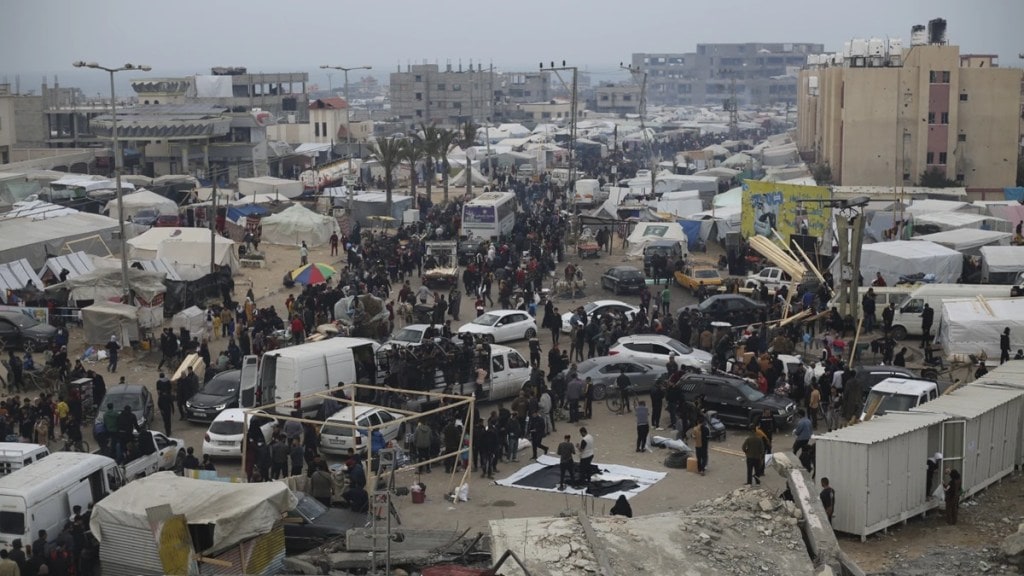By Constantino Xavier,
Four months have gone by without any significant progress on the India-Middle East-Europe Economic Corridor (IMEC), announced at the G20 summit. The MoU signed between eight leaders (the United States, the European Union, India, France, Germany, Italy, Saudi Arabia, and the United Arab Emirates) failed on the intention of meeting within 60 days to “develop and commit to an action plan with relevant timetables.” The Israel-Hamas war has naturally compromised any significant movement on fleshing out the gigantic ambition of an economic corridor through one of the world’s most divisive, conflict-ridden regions.
But the Gaza war apart, the IMEC’s geoeconomic underpinning remain relevant for India’s future. New Delhi’s investment is driven by three reasons—political, economic and strategic. First, IMEC was premised on a political logic of fuelling rapprochement between the UAE, Saudi Arabia, and Israel. With war returning to west Asia, this convergence may now stand suspended but it has not ended. Nor has it changed the shared intention of India, Europe and the US to pursue IMEC as an economic instrument to pacify the Gulf region by linking it to the North Atlantic and Indo-Pacific zones of growth.
As in the case of Europe, history shows that regional politics do not simply change as a function of economic integration. It is often outside powers that play a critical role to induce or compel adversaries to embrace economic integration. India is inclined to play this role in the Gulf, in partnership with the US and Europe.
For New Delhi, this political objective has three drivers—to gain global reputation as a conflict mediator; to protect its nine million expatriates in the region; and to prevent the rise of extremism and terrorist threats to India. This explains why much of the IMEC announcement took shape through NSA consultations, especially between India, Israel, the US, and the UAE (I2U2) in early 2023.
Second, India’s push for IMEC is also reflective of economic interests. Much guesswork has gone into identifying IMEC’s exact start and end point, as well as the definite location of its ports and rail routes. Analysts have also been assessing its economic utility compared to the maritime freight route via the Suez Canal. This mercantile view misses two crucial points: IMEC is not an end-to-end route, nor is it strictly about trade in goods. The corridor is conceived as a multi-dimensional connectivity link on three fronts: transportation infrastructure (shipping, railways), energy (green hydrogen), and digital (submarine cables).
More than a one-way, trade-focused transmission belt that is planned top-down, India sees IMEC as an inter-regional growth zone made of smaller, interdependent logistics hubs that form a supply chain. Finance minister Nirmala Sitharaman thus referred to IMEC as an attempt to “position India as a hub in new and diversified supply chains and value chains across the Indo-Pacific.”
Third, India’s initiative on IMEC reflects its geostrategic preference to align its connectivity initiatives with those of its key Indo-Pacific partners. With the US, this has manifested through the Indo-Pacific Economic Framework (IPEF) and the fact that IMEC was launched in partnership with the G7’s Partnership for Global Infrastructure and Investment (PGII). And with the EU, India is now a centrepiece of Brussel’s Global Gateway, EU-Asia connectivity and Indo-Pacific strategies.
Most importantly, from an India-centric perspective, IMEC is one of two critical connectivity arms that link South Asia to global supply chains. To the East, in partnership with Japan, India has been silently developing a still nameless industrial corridor across the Bay of Bengal, linking to the Southeast Asian manufacturing hubs. And to the West, IMEC reflects the plan to extend those supply chains with the Gulf and European markets.
To realise these political, economic, and strategic interests, and make IMEC come true, India will have to address four key challenges. First, to realise IMEC’s practical benefits and ensure it does not just an expression of political and strategic intent, the private sector and research community should also develop expert consultation and studies to assess concrete economic costs and benefits, as well as geopolitical risks and rewards.
Second, IMEC nodal points along coastal Gujarat and Maharashtra will have to align with transportation and logistics corridors that link with inland to urban growth zones such as New Delhi, Hyderabad, or Bengaluru. IMEC could also be a good opportunity to internationalise the PM Gati Shakti master plan for multi-modal connectivity. Gulf countries would benefit from accessing the logistics system to ensure more efficient planning and implementation of multiple infrastructure layers in line with India’s priorities and standards.
Third, India will also have to find ways to engage the most notably missing IMEC actors. Greece was not a signatory but is a critical player when it comes to Europe-Asia connectivity. Prime Minister Narendra Modi’s recent visit to Athens augurs well for a new era of India-Greece engagement that could also help shape the Eastern Mediterranean into a new zone of Indo-Atlantic growth. Israel was also absent from the announcement, but has declared its interest. IMEC’s potential would also benefit closer coordination with the United Kingdom and Japan.
Fourth, India should also expect headwinds from those that stand out to lose from IMEC. China is likely to play a spoiler role, seeing IMEC as a US ploy to undermine its rising influence in the Gulf region. For Russia, IMEC represents a challenging maritime bypass that reduces the importance of its own continental connectivity corridors, including the International North–South Transport Corridor (INSTC). India should also ensure that IMEC generates positive spill over effects for Turkey, Qatar and Egypt.
The Gaza war has delayed but it will not be enough to derail IMEC. The paramount logic of geoeconomic gains will eventually re-emerge with the potential to transform and pacify the region. Sooner or later, that window of opportunity will reopen. To be prepared for that, India must now take the initiative on fleshing out the promise and potential of IMEC.
(The author is Fellow, Centre for Social and Economic Progress)

